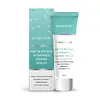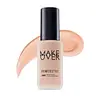Azarine Matte My Day Hydraveil Primer Serum Versus Make Over Powerstay 24H Weightless Liquid Foundation
What's inside
What's inside
 Key Ingredients
Key Ingredients

 Benefits
Benefits

 Concerns
Concerns

No concerns
 Ingredients Side-by-side
Ingredients Side-by-side

Water
Skin ConditioningDimethicone
EmollientCyclopentasiloxane
EmollientIsododecane
EmollientAlcohol Denat.
AntimicrobialEthylhexyl Methoxycinnamate
UV AbsorberCaprylyl Methicone
Skin ConditioningMethyl Methacrylate Crosspolymer
Trimethylsiloxysilicate
EmollientButylene Glycol
HumectantHydrogenated Polyisobutene
EmollientNiacinamide
SmoothingPEG-9 Polydimethylsiloxyethyl Dimethicone
EmulsifyingTitanium Dioxide
Cosmetic ColorantDicaprylyl Carbonate
EmollientMagnesium Sulfate
Synthetic Fluorphlogopite
Trehalose
HumectantZinc Gluconate
Skin ConditioningPhenoxyethanol
PreservativePentylene Glycol
Skin ConditioningEthylhexylglycerin
Skin ConditioningTriethoxycaprylylsilane
Disteardimonium Hectorite
StabilisingAluminum Hydroxide
EmollientPropylene Carbonate
SolventAllantoin
Skin ConditioningBHT
AntioxidantHydrated Silica
AbrasiveHydrogenated Lecithin
EmulsifyingTocopherol
AntioxidantWater, Dimethicone, Cyclopentasiloxane, Isododecane, Alcohol Denat., Ethylhexyl Methoxycinnamate, Caprylyl Methicone, Methyl Methacrylate Crosspolymer, Trimethylsiloxysilicate, Butylene Glycol, Hydrogenated Polyisobutene, Niacinamide, PEG-9 Polydimethylsiloxyethyl Dimethicone, Titanium Dioxide, Dicaprylyl Carbonate, Magnesium Sulfate, Synthetic Fluorphlogopite, Trehalose, Zinc Gluconate, Phenoxyethanol, Pentylene Glycol, Ethylhexylglycerin, Triethoxycaprylylsilane, Disteardimonium Hectorite, Aluminum Hydroxide, Propylene Carbonate, Allantoin, BHT, Hydrated Silica, Hydrogenated Lecithin, Tocopherol
Ingredients Explained
These ingredients are found in both products.
Ingredients higher up in an ingredient list are typically present in a larger amount.
Allantoin is a soothing ingredient known for its protective and moisturizingg properties. Because of this, it is often added to products with strong active ingredients.
Studies show higher concentrations of this ingredient can promote wound healing.
Though it can be derived from the comfrey plant, allantoin is produced synthetically for cosmetic products to ensure purity.
Learn more about AllantoinCyclopentasiloxane, or D5, is a silicone used to improve texture of products and trap moisture.
D5 is considered lightweight and volatile. Volatile means it evaporates quickly after application. Once evaporated, D5 leaves a thin barrier that helps keep skin hydrated.
It is also an emollient. Emollients help soften the skin and prevent water loss. Silicones create a silky texture in products. D5 helps other ingredients become more spreadable.
Studies show D5 is safe to use in skincare products. We recommend speaking with a skincare professional if you have concerns.
Learn more about CyclopentasiloxaneNiacinamide is a multitasking form of vitamin B3 that strengthens the skin barrier, reduces pores and dark spots, regulates oil, and improves signs of aging.
And the best part? It's gentle and well-tolerated by most skin types, including sensitive and reactive skin.
You might have heard of "niacin flush", or the reddening of skin that causes itchiness. Niacinamide has not been found to cause this.
In very rare cases, some individuals may not be able to tolerate niacinamide at all or experience an allergic reaction to it.
If you are experiencing flaking, irritation, and dryness with this ingredient, be sure to double check all your products as this ingredient can be found in all categories of skincare.
When incorporating niacinamide into your routine, look out for concentration amounts. Typically, 5% niacinamide provides benefits such as fading dark spots. However, if you have sensitive skin, it is better to begin with a smaller concentration.
When you apply niacinamide to your skin, your body converts it into nicotinamide adenine dinucleotide (NAD). NAD is an essential coenzyme that is already found in your cells as "fuel" and powers countless biological processes.
In your skin, NAD helps repair cell damage, produce new healthy cells, support collagen production, strengthen the skin barrier, and fight environmental stressors (like UV and pollution).
Our natural NAD levels start to decline with age, leading to slower skin repair, visible aging, and a weaker skin barrier. By providing your skin niacinamide, you're recharging your skin's NAD levels. This leads to stronger, healthier, and younger looking skin.
Another name for vitamin B3 is nicotinamide. This vitamin is water-soluble and our bodies don't store it. We obtain Vitamin B3 from either food or skincare. Meat, fish, wheat, yeast, and leafy greens contain vitamin B3.
The type of niacinamide used in skincare is synthetically created.
Learn more about NiacinamidePhenoxyethanol is a preservative that has germicide, antimicrobial, and aromatic properties. Studies show that phenoxyethanol can prevent microbial growth. By itself, it has a scent that is similar to that of a rose.
It's often used in formulations along with Caprylyl Glycol to preserve the shelf life of products.